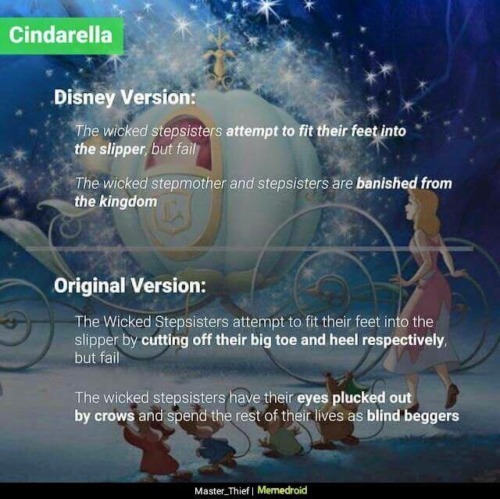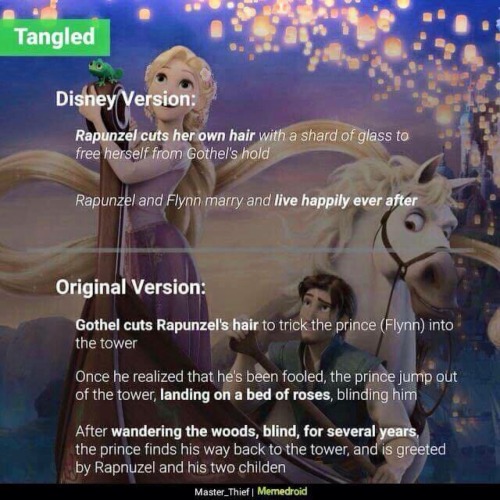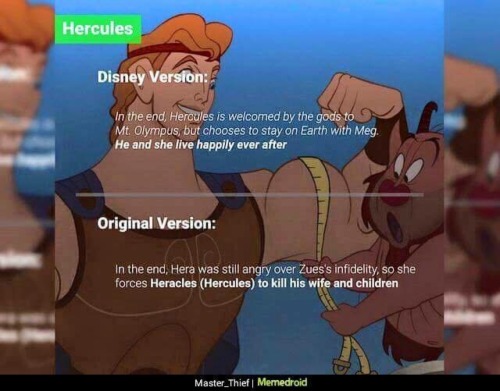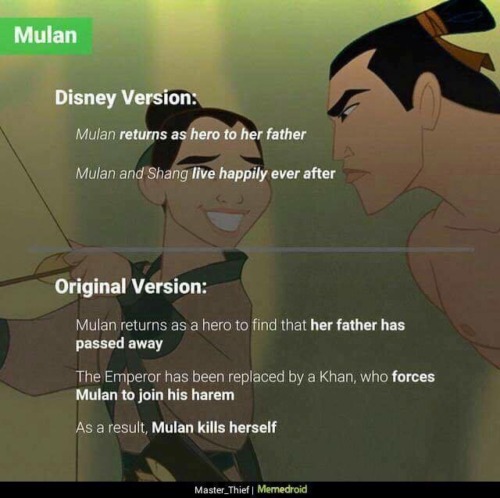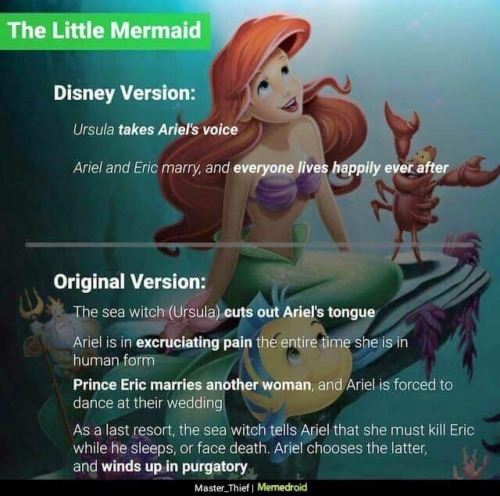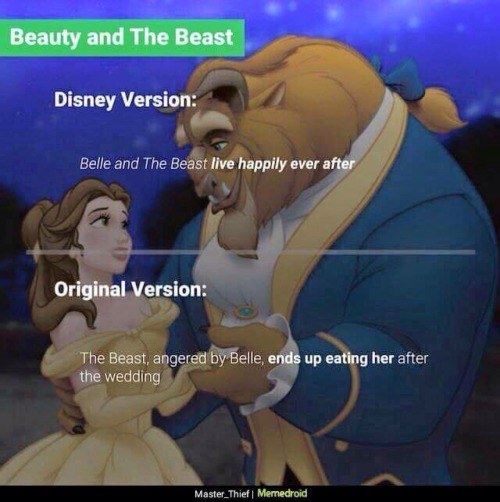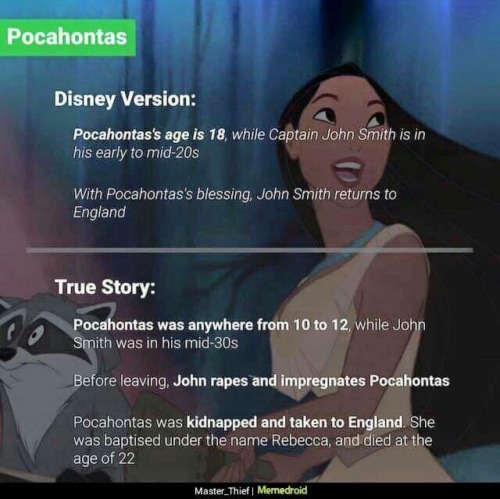classicdaisycalico: theelvenkingsunderthesky:fantastic-nonsense:smokefilledbubbles:gabnab:le
classicdaisycalico: theelvenkingsunderthesky: fantastic-nonsense: smokefilledbubbles: gabnab: lexistentialism: aes-of-spades: Disney vs. Original The last one is the most important. ^^ Ex for pocahontas was 8 we know that now Oh good, I get to debunk fairy tale ridiculousness again. It’s been awhile since I’ve been able to use my fairy tale knowledge on here. Okay, first of all, there is no such thing as an “original” version of a fairy tale; there are only “popular” or “accepted” versions. All versions of fairy tales are as valid as any other version given their history as oral tales; each tale twists and changes as it spreads to other cultures, and several tale types have similar tales that formed independently of each other in various places around the world (Cinderella is the most famous example, with over 1,000 recorded variations and some of the oldest versions being found in Greece, China, and Egypt). Second of all, several of these are patently false. I’ll just go down the list. Snow White and Hunchback are the two that are actually true. In the Grimms version of Snow White (”Little Snow White”), the Queen does ask for her liver and lungs (though this was later revised to the Queen asking for her heart) and she is forced to dance in red hot shoes until she dies. This is the norm for Snow White tales, though the specifics vary quite a lot. Hunchback is similarly grim, which makes since given that it’s based on a book by Victor Hugo (like, come on. This is the same guy that wrote Les Mis. You expected something different?). The Rapunzel one is also more or less true, as is the Hercules one. Clarification on the Little Mermaid one: she doesn’t actually wind up in purgatory. Since she was a mermaid and not a human, she didn’t have a soul and so when she killed herself, became a “daughter of the air” and can earn a soul (and thus proceed up to heaven) if she does good deeds for mankind for 300 years. Purgatory is a Catholic construction, and the probability that Hans Christian Andersen was Catholic is very very small considering that Roman Catholicism remained illegal in Denmark for nearly three centuries after the Lutheran Reformation in the mid 1500s. Cinderella: This is only true in the Grimms/German version. I’ve actually written a paper on revenge and retribution in Cinderella tales across the world, so I can tell you with a great deal amount of certainty that it greatly depends on which Cinderella tale you’re looking at for the fate of the stepmother/stepsisters. Perrault’s Cinderella/the French version, on which the Disney movie was based, ended with Cinderella forgiving her stepsisters and inviting them to live with her in the palace. The only thing they are denied is the ability to marry the prince. Pocahontas: this one is pretty half-and-half; there is absolutely no evidence that John Smith raped and impregnated Pocahontas before, during, or after his time in Jamestown. Historical accounts maintain that Pocahontas was friends with John Smith and often visited Jamestown during the years he was there. When the English reported that Smith had died after being sent back to England to treat him for injuries from a gunpowder incident, she stopped visiting the settlement for a couple of years. It’s also maintained in the historical accounts that when she visited, she often brought food and kept several of the settlers from starving. Historical accounts do not maintain that they were lovers, that she was of suitable age for a relationship (period), or that there were any sexual implications to their relationship. It is only in fictional accounts of their relationship (particularly in the Disney version, where she was significantly aged up) that that relationship is portrayed as romantic. (cont) There are a couple of scholars that maintain she was raped during her captivity by the English (which happened long after Smith left for England), but the majority of the scholarship agrees that she was not raped. Her only child is by John Rolfe and he was conceived after they were married, so the ‘raped and impregnated’ claim is wrong as well. She was also not kidnapped and taken to England. She and John Rolfe were married before they left for England…for a good two years, in fact. She and Rolfe traveled to England, stayed for a year and a half, and then boarded a ship to return to Virginia, where Pocahontas died of an unknown disease along the way. Mulan: false. I’ll let this post do the explaining for me, because it explains it better than I ever could. The actual ballad of Hua Mulan says no such thing; the ending this post describes is from a book called the “Sui Tang Romance” and is basically fanfiction of the actual Hua Mulan legend. The tragic end is “a detail that cannot be found in any previous legends or stories associated Hua Mulan.” Beauty and the Beast: patently and blatantly false. I have never been so insulted by a statement about a fairy tale in my life, and I argue about Cinderella on a regular basis. There is no BATB variant tale where the Beast ends up eating the girl after the wedding. The Beaumont/French tale (again, the version on which the Disney version was based), has the Beast dying of heartbreak because Beauty was late returning to the castle, but ends with the Beast and Beauty happily married after she proclaimed her love for him. Here are links to BATB tales around the world, just because I want to correct the awful monstrosity that was “the Beast ends up eating Belle after the wedding.” Also, here’s a link to my favorite BATB variant, the Norwegian “East of the Sun and West of the Moon,” and a link to “Cupid and Psyche,” the tale on which many BATB tales are based. The Aarne-Thompson tale type for Beauty and the Beast is 425 for anyone interested (425A tales are Cupid and Psyche tales and 425C tales are BATB tales). Basically, this post is a hodge-podge of mostly true to embarrassingly and infuriatingly false information. Do your own research, and don’t believe everything the internet tries to tell you about fairy tales. I love you Fairy tale debunkers are my heroes -- source link
Tumblr Blog : www.tumblr.com

